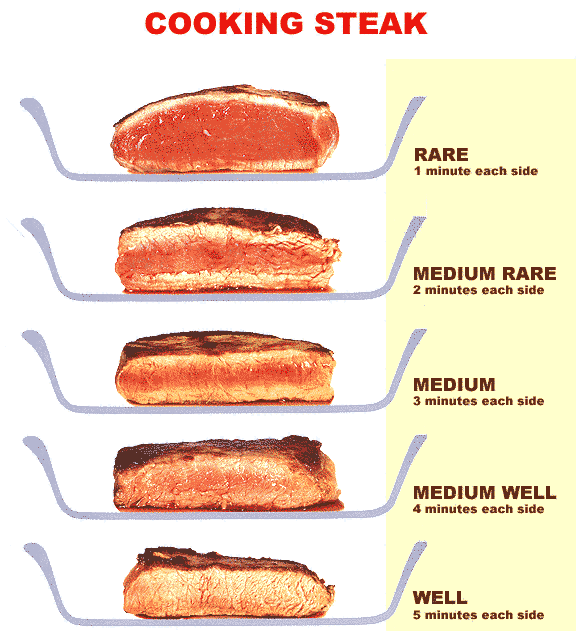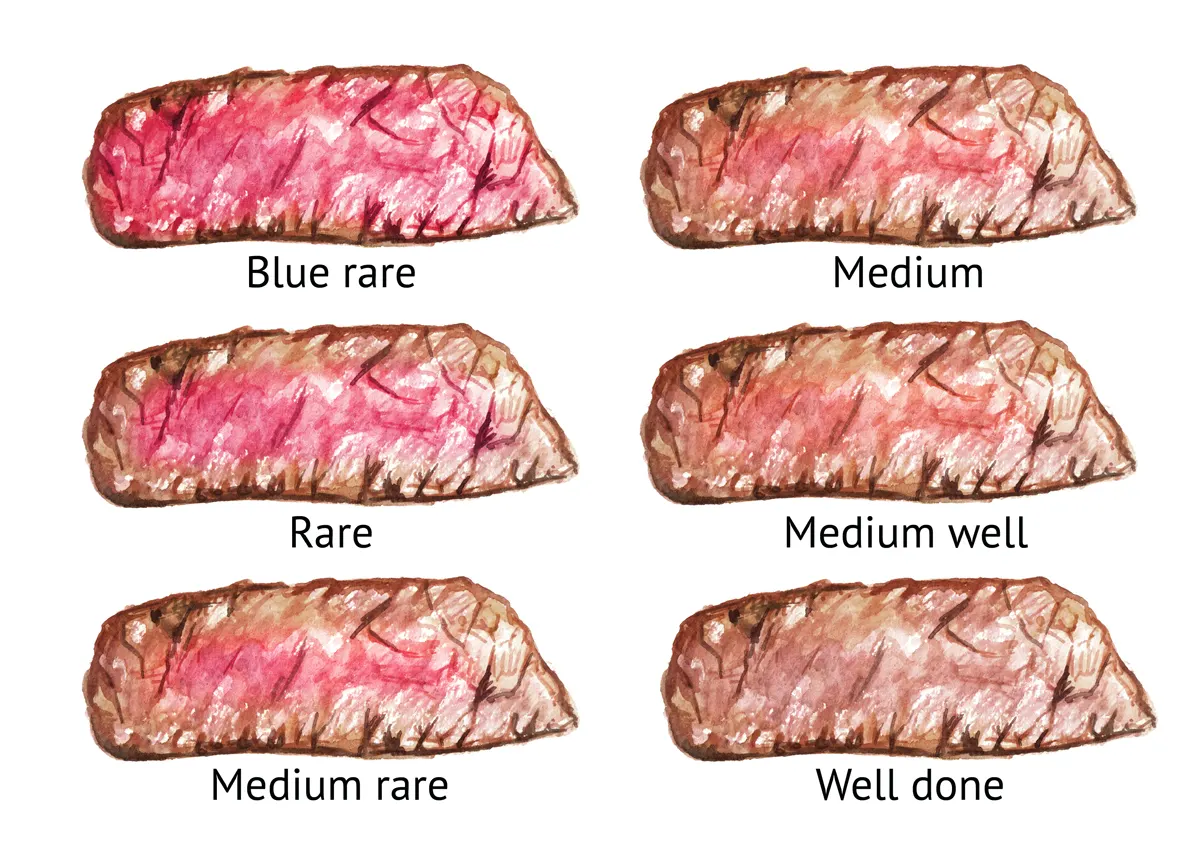Medium Rare Vs. Medium: Steak Doneness Guide
Are you ready to elevate your grilling game and achieve steak perfection? Mastering the art of steak doneness is the key to unlocking a world of culinary delight, and understanding the nuances between medium and medium-rare is the first step.
The quest for the perfect steak is a journey undertaken by both seasoned grill masters and home cooks alike. It's a pursuit that involves understanding the science of heat, the art of timing, and the subjective nature of taste. One of the most crucial aspects of this journey is mastering the various levels of doneness, with medium and medium-rare often standing as the cornerstones of the steak experience.
This article aims to demystify these two popular doneness levels, providing you with the knowledge and techniques necessary to consistently achieve steak perfection. We'll delve into the specifics of each, from the visual cues to the internal temperatures, and explore the methods to achieve the desired result. This knowledge will enable you to confidently order a steak at a restaurant, grill one at home, and appreciate the subtle differences that define each level of doneness.
Let's begin by addressing a common point of confusion: are medium and medium-rare the same thing? The answer, unequivocally, is no. While they may seem similar at first glance, they represent distinct stages of doneness, each offering a unique textural and flavor profile. The cooking time, internal temperature, and visual appearance all differ, ultimately impacting the final eating experience.
Medium rare is often touted as the gold standard for steak, favored by chefs and steak aficionados alike. It strikes a delicate balance between tenderness and flavor, offering a juicy, melt-in-your-mouth experience. The center remains a vibrant pink or red, while the exterior develops a satisfying crust. This level of doneness provides a tender bite that is not tough or chewy. The cooking process is not exactly the same as medium, as cooking time and temperature are different. The most popular temperature of beef tenderloin is medium rare. This is the most common steak doneness to order at a restaurant and cook at home. Its like biting into butter. Medium rare means the best tasting, most tender steak you can have.
Medium, on the other hand, offers a heartier bite while retaining a touch of pink juiciness. The center is hot and pink, with an internal temperature between 135 and 155 degrees Fahrenheit. The exterior is firm and cooked. The cooking time for medium is longer than that of medium rare. When cut into, the center of the steak should have a slightly pink tinge. In essence, medium offers a more robust texture compared to medium-rare.
Grilling the perfect steak isn't just about achieving the right internal temperature. It's about understanding the nuances of heat distribution, the impact of the grill itself, and the importance of resting the meat. Different grills, from charcoal to gas to electric, have their own characteristics and require slightly different approaches. The thickness of the steak plays a significant role in cooking time, and the practice of resting the steak after grilling allows the juices to redistribute, resulting in a more tender and flavorful final product.
The grill times and temperatures for steak can vary depending on the cut and thickness. For medium rare, a general guideline might be 5 minutes per side, while medium might require slightly longer. The key is to monitor the internal temperature using a meat thermometer. Pull off the grill at max 130F for medium rare. For medium steaks, the internal temperature should be between 135 and 145F.
One technique involves cooking the steak over high heat initially to sear the exterior, followed by a lower heat to cook the inside to the desired level of doneness. This method, often referred to as reverse searing, can be particularly effective in achieving a beautifully crusty exterior while maintaining the desired internal temperature.
The use of a meat thermometer is paramount in ensuring accurate doneness. Insert the thermometer into the thickest part of the steak, avoiding contact with bone, to get an accurate reading of the internal temperature. It is the easiest solution to avoid disappointment. As a general guide, follow these temperatures to determine how well the meat is cooked:
- Rare: Bright red center, pink edges, warm.
- Medium Rare: Slightly pink center and warm throughout.
- Medium: Hot and pink in the center, with an internal temperature between 135 and 155 degrees Fahrenheit.
- Well Done: No pink, cooked throughout.
In addition to temperature, the visual cues also play a crucial role. The exterior should have a nice sear, with grill marks indicating even cooking. When cut into, the color of the center will indicate the level of doneness, ranging from bright red for rare to gray for well-done. Do the same for gauging steak's firmness for medium and well done by pinching together your ring finger and then your pinky, respectively.
The carry-over heat is another important factor to consider. This refers to the residual heat that continues to cook the steak after it's been removed from the grill. There are two big factors when calculating the carry over heat: the temperature in which youre cooking at, as well as the thickness of the steak. It's essential to factor this in when pulling the steak off the heat, as it will continue to cook for several minutes.
The terms used to describe doneness can vary slightly depending on the country or region. For example, what might be considered medium-rare in one place could be closer to medium in another. The problem is that what is considered rare or well done in france is not the same as what would be called rare or well done in, say britain. When you're dining out or grilling at home, it's always a good idea to clarify your preferences with the chef or cook.
Some even order the meat by percentages e.g. From 25% for rare, to 70%, 80% and obviously 100% for well done. As a general rule, however, i would go with: For medium rare, the internal temperature should be between 130-135 degrees Fahrenheit. Medium rare steaks are warm with a pink to red centre soft and juicy on the inside and firm on the outside. For medium, the internal temperature should be between 135-145 degrees Fahrenheit. Steaks cooked to medium are hot and pink in the center, with an internal temperature between 135 and 155 degrees fahrenheit.
The level of doneness also influences the flavor profile of the steak. The more the steak is cooked, the more the proteins denature, leading to changes in texture and flavor. Medium-rare steaks tend to be more juicy and tender, allowing the natural flavors of the beef to shine through. The longer the cooking time, the more the flavors of the steak are altered, and the more the juices are lost.
Now that you understand the steak levels better, it's time to make a case for medium rare. Because of the lower internal temp, it will never be tough or chewy. Instead, the medium rare will almost fall apart in all the right ways, making it easy to eat.
I actually like somewhere between medium and medium rare. I like it to be pink inside but with just a tint of blood. When i'm out i order one of the two depending on the place, since none of them cook it the same way. I tend to err on the side of medium rare because i more often have my steak come out medium well than medium rare if i ask for.
Understanding the pros and cons of these two options will help you to decide how to cook your meat. The next cooking level jumps from medium rare to well done. In this guide, we will explain different levels of doneness and how to grill meat to perfection.
Ultimately, the best way to determine your preferred level of doneness is through experimentation. Try cooking steaks to both medium and medium-rare, and pay attention to the nuances in texture, flavor, and visual appearance. The more you practice, the more confident you'll become in your ability to achieve steak perfection, every time. Ask almost any chef or steak aficionado: Medium rare means the best tasting, most tender steak you can get. This is the most common steak doneness to order at a restaurant and cook at home.
Remember, achieving the perfect steak is a journey. It's about continually learning, refining your techniques, and ultimately, savoring the fruits of your labor. So fire up your grill, grab your favorite cut of beef, and embark on a delicious adventure that celebrates the art of steak doneness.
Article Recommendations



Detail Author:
- Name : Alexandra Kassulke
- Username : hilda.torphy
- Email : dmacejkovic@bins.com
- Birthdate : 1994-10-26
- Address : 1661 Hintz Glen Apt. 994 West Jeffereystad, AL 59407-9280
- Phone : +1-321-319-8627
- Company : Jakubowski, Schroeder and Zboncak
- Job : Food Preparation
- Bio : Nam voluptate autem tempore corporis quis fugiat. Dolorem soluta nemo ducimus voluptatem nobis ipsa magni. Illum repellat quia eveniet est voluptatem id. Omnis error aspernatur quidem atque vel illo.
Socials
instagram:
- url : https://instagram.com/danika_hackett
- username : danika_hackett
- bio : Earum veritatis pariatur fugit voluptatum sapiente. Cumque similique minima sint iste qui quos.
- followers : 2068
- following : 1757
linkedin:
- url : https://linkedin.com/in/danika9596
- username : danika9596
- bio : Possimus fuga reiciendis eum quia iusto est.
- followers : 3395
- following : 1628
facebook:
- url : https://facebook.com/danika7887
- username : danika7887
- bio : Id ratione minima et quibusdam rerum dolor.
- followers : 4911
- following : 745
tiktok:
- url : https://tiktok.com/@danika_hackett
- username : danika_hackett
- bio : Perferendis minus placeat nihil optio perspiciatis vel.
- followers : 6379
- following : 48
twitter:
- url : https://twitter.com/danika7471
- username : danika7471
- bio : Natus quia minus dolorum. Quos aut velit vel ut id iure. Dicta nemo commodi eligendi quae et sunt placeat.
- followers : 6475
- following : 1023